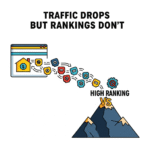
SEO advice from five years ago continues circulating through marketing blogs, courses, and agency recommendations despite no longer reflecting current search realities.
These outdated strategies consume time and resources while producing diminishing returns.
Understanding which traffic generation myths to abandon can help you focus on approaches that actually work in today’s search environment.
The myth that higher search rankings automatically generate proportional traffic increases leads marketers to obsess over position tracking while ignoring user behavior changes.
Your content might climb from position five to position two without experiencing corresponding traffic growth because search results now include features that provide answers without requiring clicks to your website.
This ranking obsession wastes enormous amounts of time on technical optimizations, keyword targeting, and link building efforts that improve metrics without improving business outcomes.
Position tracking tools and ranking reports create an illusion of progress while actual traffic and conversions decline.
Success requires measuring business results rather than just search visibility.
The myth that creating more content will solve traffic problems drives businesses to publish constantly without strategic focus.
Content volume doesn’t correlate with traffic growth when each piece of content competes with AI-generated summaries, featured snippets, and other content formats that provide immediate value to users without requiring website visits.
This content quantity obsession leads to thin, rushed articles that don’t provide meaningful value while consuming resources that could be invested in higher-impact marketing activities.
Quality content that genuinely serves user needs performs better than frequent publishing schedules that prioritize consistency over substance.
The myth that keyword research tools accurately predict traffic opportunities causes marketers to chase search volume data that doesn’t reflect current user behavior.
High search volume keywords often represent queries that Google answers directly through AI overviews and featured snippets, meaning traffic potential is much lower than tools suggest.
Traditional keyword tools show historical search data without accounting for how AI search features, voice queries, and mobile behavior have changed which searches actually generate website visits.
Optimizing for high-volume keywords often means targeting traffic that no longer exists while missing lower-volume opportunities that still drive engaged visitors.
The myth that link building significantly impacts modern search rankings keeps businesses investing in expensive, time-consuming outreach campaigns that produce minimal results.
While backlinks remain a ranking factor, their influence has diminished compared to user behavior signals, content quality, and brand recognition factors that most link building strategies don’t address.
Modern link building often focuses on metrics like domain authority and referring domains rather than actual business outcomes.
The links that move ranking needles typically come from genuine relationships and valuable content rather than systematic outreach campaigns.
Time spent on link building often generates better returns when redirected toward audience building and content promotion.
The myth that technical SEO improvements guarantee traffic increases leads to endless optimization of page speed, crawlability, and markup without addressing fundamental content and user experience issues.
Technical factors have become table stakes rather than competitive advantages, meaning perfect technical scores don’t differentiate your content in search results.
Technical SEO audits often identify dozens of minor issues that consume development resources without materially impacting search performance.
While serious technical problems can hurt rankings, obsessing over technical perfection distracts from content strategy and user experience improvements that actually influence traffic and conversions.
The myth that social media doesn’t impact SEO causes businesses to treat social platforms as separate from search strategy rather than understanding how social signals influence search visibility and brand recognition.
Social media engagement affects brand searches, content discovery, and user behavior patterns that search algorithms consider when ranking content.
This artificial separation between social media and search optimization misses opportunities to build integrated marketing strategies that reinforce each other.
Social content can drive brand awareness that leads to direct searches, while search-optimized content can provide material for social media campaigns that expand reach beyond search channels.
These myths persist because they’re based on strategies that worked in previous search environments and because many SEO tools and services built their business models around approaches that are no longer effective.
Abandoning these myths requires accepting that search marketing has fundamentally changed rather than trying to optimize harder using outdated methods.
The opportunity cost of pursuing these myths means missing chances to develop marketing strategies that align with current user behavior and platform capabilities.
Email marketing, content syndication, partnership development, and audience building often provide better returns than traditional SEO tactics based on obsolete assumptions.
Identifying which traffic generation activities actually move business metrics requires testing and measuring results rather than assuming that SEO best practices automatically provide value.
Many businesses discover that their most effective marketing strategies don’t involve traditional search optimization at all.
The time and budget spent chasing traffic myths could be redirected toward marketing approaches that provide more predictable and controllable results.
Paid advertising, email campaigns, social media engagement, and direct sales efforts often generate faster, more measurable outcomes than SEO strategies based on outdated assumptions.
Breaking free from these myths requires honest assessment of which marketing activities actually drive business growth rather than just improving vanity metrics like rankings and domain authority.
The businesses that thrive are those that focus on strategies that connect with real customers through channels where those customers actually spend time and make decisions.
Your traffic strategy should reflect current user behavior and platform capabilities rather than nostalgic memories of how search marketing used to work.
The myths that waste your time are those that assume search behavior remains static while everything else about online marketing continues to evolve rapidly.






